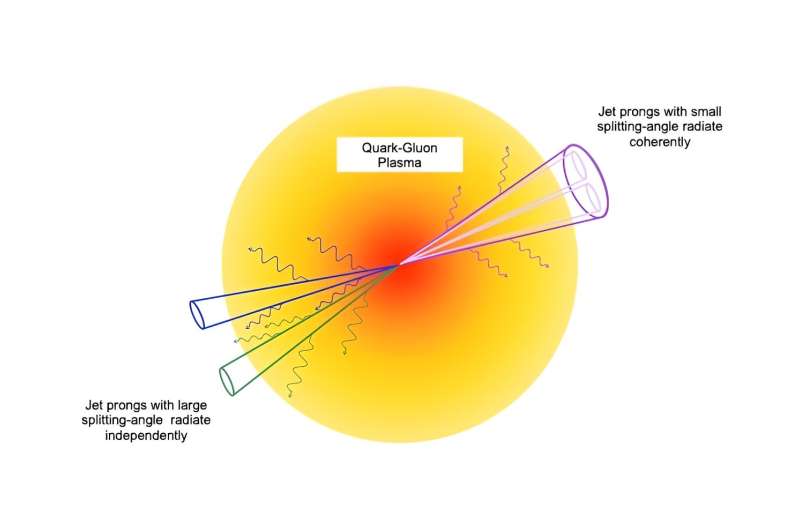This article has been reviewed according to Science X's editorial process and policies. Editors have highlighted the following attributes while ensuring the content's credibility:
fact-checked
peer-reviewed publication
trusted source
proofread
Not all jets radiate equally in quark-gluon plasma, study finds

Studying nuclear matter under extreme conditions allows scientists to better understand how the universe might have looked right after its creation. Scientists at the Large Hadron Collider achieve the conditions for recreating mini-Big Bangs in the lab by colliding nuclei at speeds close to that of light. These collisions create temperatures about one million times hotter than the sun's center.
This melts the nuclei into a fireball of their constituent quarks and gluons, known as the quark-gluon plasma (QGP). Quarks and gluons from the colliding nuclei also sometimes ricochet off one another very early on in the collision and form sprays of energetic particles known as jets. These jets lose their energy as they exit the plasma, with wide jets losing more energy than narrow jets.
Researchers have long struggled to understand the mechanisms through which energetic quarks and gluons, which split into prongs and form jets, interact with the QGP. One method to understand jet energy loss is known as the "decoherence approach."
This method leads researchers to expect that a wide jet with two prongs, each of which may act as a separate emitter of radiation, will lose more energy than a narrow jet, which acts as a single source of radiation.
In a study published in the journal Physical Review C, researchers measured the energy loss of jets with narrow and wide structures in the QGP. The results confirm for the first time that the plasma treats each prong of a jet independently only when the prongs are separated by a critical angle that is large enough for the QGP to interact with the jets as independent entities.
For the first time, researchers have measured the energy loss experienced by jets traversing the QGP as a function of its substructure using collision data collected by ATLAS, the largest general-purpose particle detector experiment at the Large Hadron Collider.
The scientists implemented an algorithm to successfully combine information from the different subdetectors in ATLAS and build a precise picture of the internal structure of the jet in the dense heavy-ion collision environment. The result indicates that the structure of a jet is characterized by its opening angle, and jets with a wider opening angle are observed to lose significantly more energy in the QGP than narrow jets.
This result confirms the decoherence hypothesis, which predicts the emergence of a critical angle in the first hard splitting of a jet, above which the jet loses energy "incoherently" as two emitters. The new results establish that the QGP does not modify the hard substructure of a jet passing through it but rather preferentially quenches jets with a wider substructure.
More information: G. Aad et al, Measurement of substructure-dependent jet suppression in Pb+Pb collisions at 5.02 TeV with the ATLAS detector, Physical Review C (2023). DOI: 10.1103/PhysRevC.107.054909
Journal information: Physical Review C
Provided by US Department of Energy




















